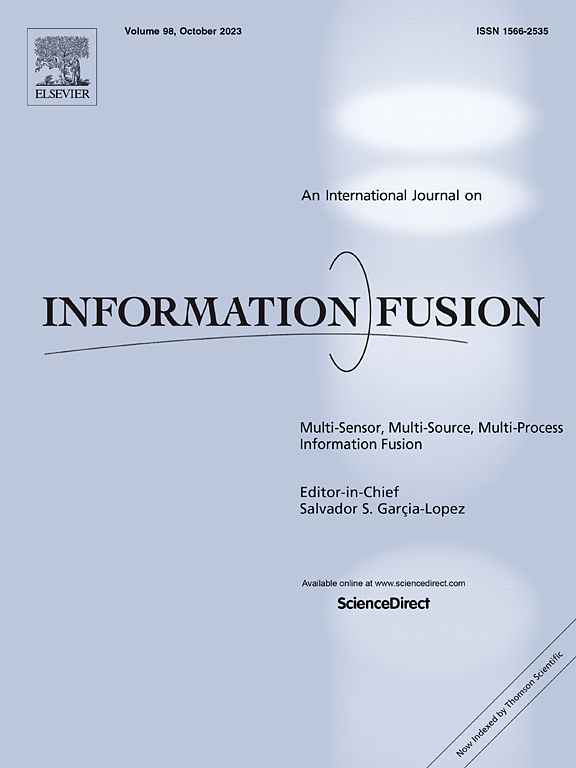Side information-guided deep unfolding network based on self-supervised learning for dual-camera compressive hyperspectral imaging
IF 14.7
1区 计算机科学
Q1 COMPUTER SCIENCE, ARTIFICIAL INTELLIGENCE
引用次数: 0
Abstract
Dual-Camera Compressive Hyperspectral Imaging (DCCHI) extends the CASSI system by adding a complementary panchromatic (PAN) camera to enhance hyperspectral image (HSI) reconstruction. Its potential broad applications make it attract great attentions. However, current DCCHI reconstruction methods face several challenges: 1) Existing regularization methods, based on hand-crafted priors, struggle to capture the complex intrinsic structure of HSI. 2) Deep learning-based approaches require large amounts of ground truth data for training. 3) The rich structural information in PAN images is underutilized. To address these issues, in this work, a novel side information-guided deep unfolding self-supervised network model is proposed to reconstruct HSI solely from compressed snapshot measurements and PAN images. Firstly, a Guided Deep Spatial-Spectral Attention Network (GDSSAN) is designed as a regularizer for the DCCHI reconstruction problem. This network effectively captures deep spatial-spectral features of HSIs, leveraging the non-linear capabilities of neural networks. Secondly, a Guided Feature Extraction Pyramid (GFEP) Block is constructed to extract multi-scale features from the PAN image, guiding both the encoding and decoding processes at different scales to enhance the robustness and fidelity of HSI reconstruction. Thirdly, a dual-domain hybrid loss function is introduced, which integrates the physical imaging mechanism of DCCHI with the spatial-spectral fidelity of HSIs, further enhancing the model's reconstruction performance. Extensive simulations and real-world experiments demonstrate that the proposed method adapts to various experimental scenes without training requirement, showcasing its strong generalization ability. Moreover, it significantly outperforms existing state-of-the-art (SOTA) methods in both quantitative metrics and visual comparisons.
基于自监督学习的侧信息引导深度展开网络双相机压缩高光谱成像
双相机压缩高光谱成像(dcci)扩展了CASSI系统,增加了一个互补全色(PAN)相机来增强高光谱图像(HSI)的重建。其潜在的广泛应用前景引起了人们的广泛关注。然而,目前的dcci重建方法面临着几个挑战:1)现有的正则化方法,基于手工制作的先验,难以捕捉恒生指数复杂的内在结构。2)基于深度学习的方法需要大量的地面真值数据进行训练。3) PAN图像中丰富的结构信息未得到充分利用。为了解决这些问题,在这项工作中,提出了一种新的侧面信息引导的深度展开自监督网络模型,仅从压缩快照测量和PAN图像中重建HSI。首先,设计了一种引导深度空间-频谱注意网络(GDSSAN)作为dcci重构问题的正则化器。该网络利用神经网络的非线性能力,有效地捕获了hsi的深度空间光谱特征。其次,构建引导特征提取金字塔(Guided Feature Extraction Pyramid, GFEP)块,从PAN图像中提取多尺度特征,指导不同尺度的编码和解码过程,增强HSI重构的鲁棒性和保真度;第三,引入双域混合损失函数,将dcci的物理成像机制与hsi的空间-光谱保真度相结合,进一步提高了模型的重建性能。大量的仿真和实际实验表明,该方法无需训练即可适应各种实验场景,具有较强的泛化能力。此外,它在定量指标和视觉比较方面都明显优于现有的最先进(SOTA)方法。
本文章由计算机程序翻译,如有差异,请以英文原文为准。
求助全文
约1分钟内获得全文
求助全文
来源期刊

Information Fusion
工程技术-计算机:理论方法
CiteScore
33.20
自引率
4.30%
发文量
161
审稿时长
7.9 months
期刊介绍:
Information Fusion serves as a central platform for showcasing advancements in multi-sensor, multi-source, multi-process information fusion, fostering collaboration among diverse disciplines driving its progress. It is the leading outlet for sharing research and development in this field, focusing on architectures, algorithms, and applications. Papers dealing with fundamental theoretical analyses as well as those demonstrating their application to real-world problems will be welcome.
 求助内容:
求助内容: 应助结果提醒方式:
应助结果提醒方式:


